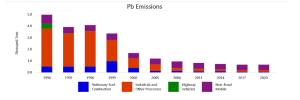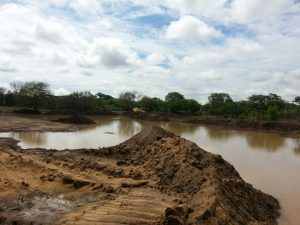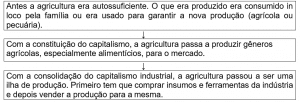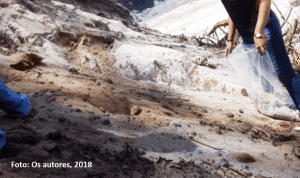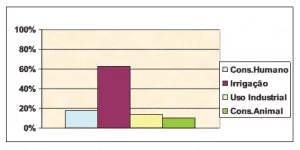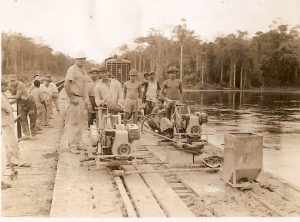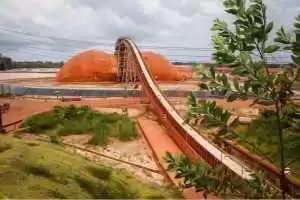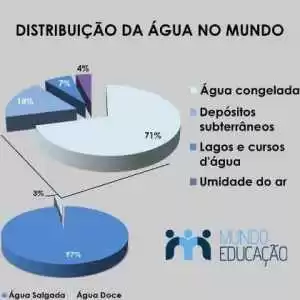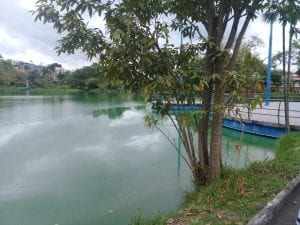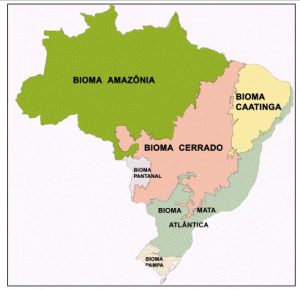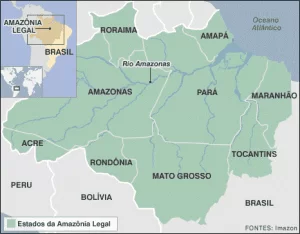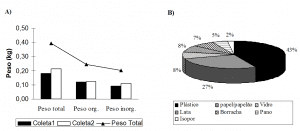ORIGINAL ARTICLE
TRENTIN, Iran Carlos Lovis [1]
TRENTIN, Iran Carlos Lovis. Climate Change and Agroecology in the Development of Rio Grande do Sul-Brazil. Revista Científica Multidisciplinar Núcleo do Conhecimento. Year 06, Ed. 03, Vol. 12, pp. 39-62. March 2021. ISSN: 2448-0959, Access Link: https://www.nucleodoconhecimento.com.br/environment/climate-change, DOI: 10.32749/nucleodoconhecimento.com.br/environment/climate-change
ABSTRACT
The central proposition of this article is to understand and discuss the situation generated by the constant droughts that plague the agricultural economy of several regions in Rio Grande do Sul in recent decades, especially with the adoption of degrading and polluting productive models since the 1970s. Also discuss some information about the natural phenomena that intensify the constant droughts, as well as the human action in the worsening of droughts. For this, we conducted a wide bibliographic research and interviews with researchers in the area. From this, it was identified that agroecology as a model of sustainable agriculture is an alternative to replace the dependent and degrading model of ecosystems in the production of food for gaúchos and for export. Also, with this sustainable model of production in agroecosystems, it is possible to guarantee environmental, economic and social improvements to the families of farmers from all agricultural regions, in addition to mitigating the constant droughts and droughts that have become frequent in recent decades, causing very large economic and environmental losses for all the production of Rio Grande do Sul.
Key Words: Climate Change, Poverty, Regional Imbalance, Agroecology.
1. INTRODUCTION
In recent years the theme of significant climate change has gained emphasis around the world. Researchers from several countries have come to a close, where some presented a conformist view that changes are natural and others counter, with very strong arguments, that climate change is caused by the uncontrolled action of man and capital over nature. In recent decades many reports and reports from international agencies have presented these two views and obtained supporters according to their interests.
But one thing we are all sure of, the climate is altered and this causes significant changes in the environment, especially in a country like Brazil that has continental dimensions and several biomes that have been established millions of years ago. The biodiversity of each biome is altered, for every tenth of the temperature that changes in a prolonged way to more or less. And many species can even disappear or be transformed, losing characteristics of their species.
In addition, other issues deserve to be discussed and analyzed, such as: the fires that increase each year in the midwest and in the Amazon region, the increase in temperatures in the semi-arid region of the Northeast, the advance of the sea on the Brazilian coast due to its increase, extreme events of rain and more frequent temperature in the large metropolises of the country, and in the mountainous regions with high population occupation , as well as a higher incidence of transmission of infectious diseases, all caused mainly by the current increase in greenhouse gas levels.
The agricultural model developed in Brazil since 1970 known as the “green revolution” based on the intensive use of synthesis insums, oil products and machinery, ensured a productivity increase by area, but also caused dependence, degradation, contamination and pollution of the environments. (TRENTIN, 2015)
Many of these, factors are listed by several researchers as promoters of the annual temperature increase and that cause constant climate change across the globe. Understanding these climate changes and observing their possible relationships with the constant droughts and droughts in southern Brazil is the objective of this work. As well as list sustainable agriculture models capable of mitigating or mitigating these harmful effects on climate change.
In the development of this work, we sought the identification of papers, articles and publications that discussed this theme and could contribute to identify the relationship between the agricultural-climate-climate-drought-alternative model of sustainable production in order to contribute scientifically to this problem. In addition, several interviews were conducted with researchers from different areas, farmers and technicians in order to better understand this theme and identify possible alternatives to mitigate climate change.
2. CLIMATE CHANGE
Thus, the UN defines in Art. 1of the Convention on Climate Change, 1992, as: “climate change is understood as a change in climate directly attributed to human activity that alters the composition of the world atmosphere and that adds to the natural variability of the climate observed during comparable periods of time.”
Climate change derives mainly from human activity, by the intensive use of fossil fuels (coal, oil, gas, etc.). and deforestation and forest loss in the most different biomes of the globe. (ALTIERI AND NICHOLLS, 2013).
The same authors also corroborate that global warming has intense environmental impacts such as melting glaciers and polar seas, as well as in agroecosystems and their biological processes, such as flowering and germination periods of plants for example. The international press also reports every day some climate change in some part of the globe as “Alpes lose 10% of the ice in a year”, (FOLHA DE SÃO PAULO on 1/12/2005).
On all continents there has been great climate change in the last century. Temperatures in traditionally cold regions rise faster than the global average. As an example, “in 2003 alone, 10% of the glaciers in the Alps melted,” according to a report published in November 2005 by the European Union’s Environmental Agency. (AGÊNCIA AMBIENTAL UNIÃO EUROPEIA, 2005 in MMA, 2010).
This warming of temperatures and climate change can increase in addition to water scarcity the incidence of serious diseases and epidemics.Especially from tropical diseases, such as malaria, dengue and dysnteria. And poorer regions are more susceptible to these problems either by worsening health conditions or by droughts affecting food production for Community food security.
As a large contingent of families living in poverty are in rural areas especially in Africa, Asia and Latin America these are most hampered by rising temperatures and climate imbalances because their plantations and animals that are used for food suffer more and the supply of local food decreased every year.
All these climate changes affect the poorest rural populations in a much more catastrophic way, because they are those living in the most remote regions, with rugged reliefs, with smaller housing resources and food security and sovereignty. Poverty levels in rural areas increase around the world and these farmers suffer from the catastrophic effects of the climate, even without having participated in this change. For in many cases the changes or aggressions to the environment that have been carried out on another continent by conventional farmers, highly dependent on chemical, pesticide and oil supplies, and or by heavy industries, first affect the most vulnerable populations that are thousands of kilometers from the disaster-generating sources.
In Brazil, studies published by the Intergovernmental Panel on Climate Change (INTERNATIONAL PANEL ON CLIMATE CHANGE – IPCC, 2001) concluded that “the average temperature of the atmosphere has increased by 0.6 ºC + 0.2 ºC during the 20th century”. Reports from the IPCC and several other universities have shown “that between 1900 and 2100 the global temperature could warm up to between 1.4 and 5.8 ºC”. If this occurs, serious environmental problems will be observed each year in every corner of the planet.
In this sense, we need to understand why the climate is changing so much in recent years. Studies conducted by the Brazilian Ministry of the Environment state that the climate varies naturally depending on the weather and location, but that in the last 2 centuries this intensive burning of fossil fuels is more visible and causing disasters in various regions of the planet.
Segundo Nobre et al (2012, p 8)
in the last 400,000 years, there have been four distinct cycles. These cycles are glacial and interglacial. At the interglacial peak, where we are, the temperature is higher about 5 °C to 6 °C compared to the peak of the last glacial period, 20,000 years ago.
120,000 years ago, we had the last interglacial period and the temperature was slightly above the current temperature and these slight alternations are natural in time and space.
Nobre et al. (2012, p 8) also states that for example, “in the last glaciation, 20,000 years ago, as already said above, the planet’s surface was 5 °C to 6 °C colder”. And in this period the Earth took 10,000 years to warm up and agra in a short time increased much. But now, over the past two decades, it is warming almost 0.2 °C per decade, which is a speed 50 times faster than the glacial-interglacial natural cycle. So some different things are happening. If all this were natural it would have to be explained easily, because there is no scientific justification that this great heating speed is merely natural.
Studies by researchers around the world in recent decades claim that due to disorderly global warming, ocean levels have already risen by 20 cm, and that snow cover in the earth’s hubcaps has been decreasing every year.
According to the IPCC, (2007 in NOBRE 2012, p. 11), it is essential to note that the ocean is warming. if
the planet is warmer, we have to imagine that the Earth System – continental surface-atmosphere – cryosphere-ocean – is in a higher state of energy, that is, it has more energy. And that energy is going to the ocean. Eighty percent of this energy increase – because the planet’s average temperature is 0.8 °C warmer – goes into the ocean.
Charts and tables from ocean temperature monitoring centers show this warming across the globe.
As Altieri and Nicholls (2013) have stated, the temperature rises because we have more harmful gases in the atmosphere. And there is no doubt that these gauzes, are increasing is just looking at our dominant production systems, whether agricultural or industrial, which are based on the combustion process – when we burn coal, oil, natural gas, forest, etc., we generate carbon dioxide. This increase in CO2, which is in greater proportion in the atmosphere, produces the warming of the temperature on the surface.
Even though some researchers and transnational companies try to mask that warming is caused by the addition of CO2 in the atmosphere by inorganic processes, such as volcanoes, fissures, etc., studies conducted worldwide contradict this position. And there is consensus among researchers committed to the well-being of the world’s population that some things must be done to reduce these rising carbon dioxide emissions.
During ECO-92 or Rio-92 (1992), in the final report there was a promise to reduce CO2 emissions. It is 2013 and emissions have only increased in all regions of the globe. According to Nobre et al, 2012, “CO2 emissions of fossil origin have increased by 43% in the last 18 years.” The 15th Conference of the Parties (COP15) of the United Nations Framework Convention on Climate Change, held in Copenhagen in 2009, said in its final document “that every effort must be made not to let the temperature rise by more than 2°C.” Fact that we know is not being fulfilled by almost any country in the world.
3. CONSTANT DROUGHTS IN SOUTHERN BRAZIL
In recent years we have observed the constant droughts in the southern region of Brazil, droughts that have already become called droughts. The last 10 years 7 have been of droughts in the summer, river levels have never been so low and the lack of water is constant in many southern regions. (TRENTIN, 2019)
All these changes are endorsed by some researchers who claim that this has always existed, want at all costs to justify the catastrophe as something cyclical. Climate change in southern Brazil, especially droughts, is commonly reported by older farmers.Droughts have always existed, but what you can see is that in the last 50 years they have become more intense and summer temperatures are higher.
This seems to coincide with the beginning of the modernization of agriculture via the “green revolution” with its various harmful effects on the environment, especially the deforestation of several forest areas in southern Brazil.
As we know, no researcher, who defends the conventional and predatory model of the environments, talks about the negative impacts of deforestation in any Brazilian biome and in other regions of the planet. And it is known that this deforestation can compromise the climate of both the Amazon region and other regions that benefit from the moist masses formed in this forest.
In recent years the observations of the climate in the country, in larger time scales revealed profound changes. This serves as a basis for analyzing the climate of the future, thus trying to separate the normal variations observed, from the variability forced by the action of man that induce climate change.
3.1 EL NIÑO AND LA NIÑA
In recent years these two words of the Spanish language have become part of the daily gaúcho. It is common to hear about el Niño and La Niña on inland radio, in the service lines of agricultural cooperatives and also in the chimarrão wheels among family farmers from all municipalities.
Researchers from different international research institutes found that these phenomena considerably affect the behavior of rainfall throughout Brazilian biomes. In the North, Northeast regions, droughts occur during El Niño and southern Brazil, droughts during La Niña and excessive rains, including el niño floods. Thus, if El Niño increases in frequency or intensity in the future, Brazil will be exposed to more frequent droughts or floods and heat waves. And according to Altieri and Nicholls (2013 in TRENTIN, 2015, p. 10), “would it increase why? Because agricultural and industrial production forms use a lot of fossil fuel and destroy the environments.”
About these most frequent heat waves is that we want to deepen to try to understand what happened this summer of 2014, in southern Brazil and that according to our research caused substance losses in agricultural production gaucho.
Several Brazilian researchers have observed that the El Niño and La Niña phenomena on the Equatorial Pacific region that alters TSM (Sea Surface Temperature) over the Tropical Atlantic favor associated with other phenomena, a large part of the variability in the different annual climate seasons in South America. This reflects significantly in the cereal-producing zones of the Southern Cone for example.
El Niño and La Niña are characterized by the cooling or warming of surface waters in the Pacific Ocean, especially near the equator. And the combination of different atmospheric circulations caused by the heating or cooling of the ocean surface affects the latitudinal positioning of the Intertropical Convergence Zone (ITIC) in the Atlantic, interfering on rainfall indices in the Atlantic and Amazon biomes.
Several authors who analyzed the behavior of ocean temperature, state that interannual variability of TSM and winds over the Tropical Atlantic exert a profound influence on climate variability on South America, at the global level, among these are cited, (ROPELEWSKI AND HALPERT 1987, 1989; ACEITUNO 1988), with studies on the Northeast region of Brazil (HASTENRATH, 1984; NOBRE AND SHUKLA, 1996; ALVES et al. 1997; RAO et al., 1993; UVO et al., 1998; XAVIER, 2001). On the Amazon biome, we can mention, among others (MARENGO, 1993; MARENGO AND HASTENRATH 1993; MARENGO et al., 1998, 2006; RONCHAIL et al. 2002; BOTTA et al. 2003; SOUSA and AMBRIZZI, 2006), and on the South and Southeast of Brazil (KILADIS And DIAZ, 1989; DIAZ And STUDZINSKY, 1994; GRIMM, 1997a and b; NERY et al., 1997; GRIMM et al., 2000, BERLATO and FONTANA, 2003). (MMA, 2010).
In the Amazon region, for example, El Niño impacts are frequent in the north and center of the region, such as the droughts of 1925-26 (WILLIAMS et al., 2005), 1982-83 and more recently in 1997-98. (MARENGO et al., 2006, in MMA, 2010).
The influence of El Niño and La Niña in South America, considering the history of these events during the last 50 years is visible. And it is also likely that during some El Niño or La Niña events there will be no representative impacts in some regions because as pointed out they are associated with other geographic behaviors of the globe. When El Niño is active in Brazil, droughts in the Northeast and Amazon predominate and more rainfall in the South predominates. And throughout the southern cone, higher atmospheric temperatures are observed, whether in summer and even in winter.
The Southern region presents the impacts of El Niño from winter and spring and reaching greater expression this phenomenon in summers. The opposite is observed when it tends to dry or less rain during La Niña, in winter and spring.
The temperature-increasing effects of ocean waters in the Pacific affect wind systems over the entire equatorial region. And so these charged clouds that produce heavy rains in the vicinity of Indonesia, move influenced by sea currents, to the east, to the Central Pacific and, later, to the west coast of South America, favoring precipitation in the Peruvian desert, for example.
Changes in rainfall conditions in the Pacific cause changes in the weather conditions of various regions of the globe. As an example, we mention the large and constant droughts in India, northeastern Brazil, Australia, Indonesia and much of Africa that may be due to the association of this phenomenon with other variations, as well as some floods in the South and Southeast of Brazil, Ecuador, Peru and the midwest of the United States, at some times of the year.
Also, in some areas, according to Silva Dias and Marengo, (2002 and 2006, in MMA, 2010) observed higher temperatures in the central and southeastern regions of Brazil, during the winter season, and in others there are cold and excessive snow. This summer in southern Brazil was extremely hot. Intense heat waves remained for up to 10 days uninterrupted. And it is known that these climatic anomalies associated with the El Niño phenomenon can cause serious environmental and socioeconomic damage, especially in agricultural areas of impoverished regions.
Family farmers and among these the poorest are more vulnerable to climate change, as reducing a few kilos of annual production can compromise the food security of these families in a longer period of drought for example.
And as in nature everything is cyclical, also occur the phenomenon contrary to El Niño, that is the La Niña which is the heating of the waters of the Western Pacific and cooling of surface waters in the central part of the Pacific. This phenomenon usually occurs less frequently than El Niño. These climatic variations associated with the La Niña phenomenon are inverse to those observed in El Niño, but the phenomenon is not constant, that is, variations always occur during the year. El Niño can be characterized as cyclical, not regular reappearing on average in the range of two to seven years. (MMA, 2010).
The effects of these phenomena are observed every year in Rio Grande do Sul, among these we can mention that the flows of rivers in southern Brazil that have low values during La Niña years, while during El Niño they remain with more water available and the flows are higher, for example. And as the vasão of rivers are mostly fed by rains, this means that droughts in Rio Grande do Sul, a state with high agricultural production of commodities for export, cause large losses thus generating significant damage to the state, farmers and especially the most impoverished and dependent regions of agriculture.
The impacts of El Niño in the Southern region have been identified in studies by Grimm et al. (1997 a, b and 2000) and Berlato and Fontana (2003), among others in MMA (2010). The greatest impacts are felt in agricultural production, especially in commodities for export that depend on the cycles of rains mainly in the southern summer.
These authors identified that the average soybean and corn yields in Rio Grande do Sul during the influence of El Niño in 1995/96, 1997/98 and La Niña in 1998/99 and 1999/2000 were modest in the La Niña years, and reiterate that the average yield gains of the state’s major commodities were higher in El Niño years.
Other researchers say that El Niño and La Niña are natural phenomena that occur from time to time and that we cannot interfere. These natural phenomena and variations of the planet’s climate system, have existed for thousands of years and will continue to exist, we hope for many thousands more years.
In recent decades, in southern Brazil, the systematic increase in rainfall in some years and droughts in others are observed in rainfall records, carried out by agricultural cooperatives and climate research centers.
As already reiterated, in addition to the natural phenomena of el niño and la niña, the changes in the environments caused by human intervention increase the frequency and intensity of these phenomena. Constant deforestation and changes in land use using heavy machinery and synthesis insums for cereal production, for example, in the most important mercosur basin of the Rio da Prata, have increased rapidly in recent decades and it is perceived that these actions modify the thermodynamic characteristics of the low atmosphere.
In nature the system is complex and these changes suffer the effects of the complex interactions between climate, hydrology, vegetation and the management by men of water and land resources, that is, the way of life of predatory exploitation of agroecosystems. In the available literature we found evidence that changes caused by the green revolution in land use in the upper paraná, Paraguay and Uruguay river basins have generally contributed more than 28% to the average flow of the Paraná River since 1970. (MMA, 2010).
Tucci and Clarke (1998, in MMA, 2010. p. 10) realized that “this increase in river flow occurred after large areas experienced deforestation or changes in land use”. The intensive use of agricultural and industrial activities in the region led to a transition from coffee to soybean and sugarcane, and cattle raising in the upper Paraná basin. This has increased greatly in recent years due, especially to the high prices of commodities for export.And some summer crops like soybeans, need intensive preparation of the land that is done with the use of machines and addition of oil-based insums. (ALTIERI AND NICHOLLS, 2013).
Another study in the State of Paraná revealed that the Iguaçu River basin has also shown constant increases in flow rate since 1970, even though in this basin there have been few changes with land use and deforestation in recent decades (GARCÍA E VARGAS, 1998, in MMA, 2010).
A recent analysis of trends in flows at the global level is presented by Milly et al. (2005). Where they present the variations during the twentieth century in South America, they reveal that “the most important is the increase in flows in the order of 20-40% in the flows in the Prata basin, consistent with the positive rainfall trends in this basin”, and in observation posts of the Paraná River. (MMA, 2010).
In the summer of 2004-2005 in southern Brazil, the total annual rainfall exceeded the average in the State of Santa Catarina, but in the east and northwest of Rio Grande do Sul and, the coast and south of Paraná, showed significant decreases in rainfall indices. Thus, the entire region had a rainfall deficit during the months of December 2004 to March 2005. In this period, the cumulative total rainfall was between 100mm and 500mm well below historical averages. (MMA, 2010).
When droughts occur in Rio Grande do Sul, they also cause great damage to agricultural and livestock production, they also generate water supply problems for the population of many municipalities. And the family farmers who produce the vast majority of food are the most affected by droughts. These in addition to losing their production destined to trade, such as soybeans, corn, vegetables or milk, for example, also lose production for family self-consumption. Droughts thus cause two immediate losses for family farmers, in addition to losing the monetary inflow by selling the products, they need to make available another financial amount to purchase the food, which they were also unable to reap this year.
Thus, indebted gaúcho family farmers become more impoverished in periods of drought. Droughts cause crop declines mainly in recent years when the agricultural commodity production market is heated. The most affected product so far is soybeans, a seal of the Brazilian trade balance.
The National Supply Company (Conab) estimated for the period 2004/2005 that production in the harvest would be 53.119 million tons, 8.281 million tons below the December forecast, which indicated a harvest of 61.4 million tons. In the 2003/04 crop, farmers were able to harvest more than 49.770 million tons of soybeans, our main agricultural export product.
And even with all this production that means a lot in the Brazilian trade balance, governments in most cases, then inattentive to the situation of family farmers and adopt only palliative measures of support. Negotiations on agricultural debt in dry years are dramatic and slow, and farmers, for example, virtually at most bank branches need to beg for care.Governments despite so many examples and scientific reports already published still do not treat climate change issues with the respect they deserve.
Corn due to the area planted in RS, is usually after soybean, the second crop most affected by droughts. As an example, cereal harvesting totaled 39.03 million tons in the 2004/05 harvest, against 42.191 million tons in 2003/04. The national drop in this harvest compared to the estimated in December was 10% or 3.16 million tons. (CONAB, 2006)
Recent research on maximum and minimum temperatures in southern Brazil during the period 1960-2002 (MARENGO E CAMARGO, 2010) pointed to a systematic warming of the Southern region. In this summer of 2013/14, southern Brazil had very high temperatures. The heat waves reached numbers previously never identified in the measurements and lasted for several uninterrupted days. Data from our field research revealed that even with rainfall in the historical average, in this period, these heat waves affect agricultural productivity in the state, especially in regions with a predominance of poor family farmers with steeper soils. Figure I.
The map presents us with two significant regions of presence of more impoverished family farmers and less suitable soils for the development of activities known as agribusiness, based on the intensive use of modern machinery, industrial equipment, oil and pesticide summing, which are the municipalities located in the great Uruguay River Valley and in the region known as the south-mountain range, from the vicinity of Santa Cruz do Sul to Pelotas.
In addition to the productivity of agriculture, these climatic oscillations cause other problems for gaucho society. As we have reiterated the difficulty in water supply in several regions and especially the low collection of taxes generated by the production chain in years of drought, which further limits the state’s performance in public policies to mitigate these effects.
Figure I: Distribution of GDP per capita per municipality of RS in 2009.
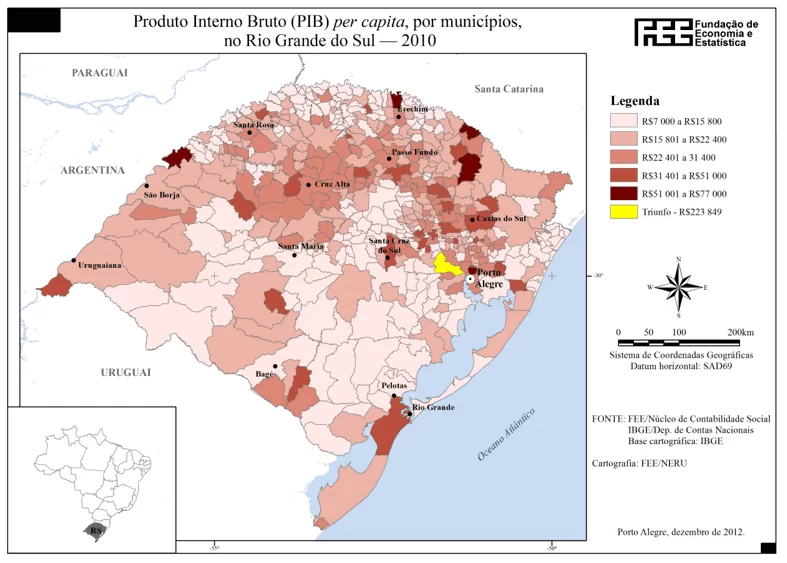
Thus, in regions where GDP per capita is lower, the drought causes the economic situation to get worse. And poor farmers tend to become poorer or more indebted in these frequent drought periods. This affects the whole of society and the local-regional economy.
These constant economic losses in the economy of these communities further aggravate the regional imbalance of Rio Grande do Sul, which even in the 21st century has not yet managed to solve structural problems in many regions.
And every day it is necessary to take more sustainable agricultural techniques so that droughts that have become part of the daily gaúcho, do not cause even more impoverishment of regions with agricultural production.
3.2 AGROECOLOGY AS AN ALTERNATIVE TO DEVELOPMENT
In the late 1970s and early 1980s, some researchers, including Gliessman, Altieri, Eric Giménez, Nicholls, Zevilla Guzman, among others, began to format what we now know as agroecology, this science that we also call a model of sustainable agricultural production. At this time several studies pointed to several negative changes, caused by the green revolution, in the different ecosystems of both rich and developing countries. Making them start to seek new models of agricultural production more sustainable in time and space.
Thus, a reference publication emerges, in this period, that of the researcher Stephen R. Gliessman, from the University of California – USA, who writes in 1996, El Concepto de Agroecosistemas, where he develops a series of concepts seeking to understand and interpret in a systemic way agroecosystems.
Gliessman (1996), states that “agroecosystems are production units”, such as farms, farms, fincas, land, farms, where farmers interact with each other and with nature present, that is, they form an agroecosystem. And it states that “in order to understand the concept of agroecosystems of a food production system, we need to know the flows of energy inflow and output and their interrelations.” He goes on to say that “the ecosystem is a system of complementary relationships between living organisms in a given environment and at a certain time, where it remains in dynamic equilibrium, always considering its structure and functions”.
According to Gliessman, (1996) “ecosystems are formed hierarchically, by individuals with specific characteristics that bring to it a series of components making them “able” to live in a given time and space”; and also,
by populations that are groups of individuals of the same species, where one must understand the factors that correspond to the size and growth of this population in order to understand the capacity of the environment to support this population in a period of time. (GLIESSMAN, 1996)
Agroecologists differ from conventional agronomists “who care about determining the optimal quantity and distribution of a single population in an environment to ensure greater productivity.” (GLIESSMAN et al, 1996 in TRENTIN, 2021, p 234).
In natural ecosystems, populations of different populations are in constant interactions both in space and time in order to organize a community, or a group of individuals who interact with each other. Thus, “the level of interrelations affects the distribution and abundance of species in the community”. (ALTIERI AND NICHOLLS, 2010).
In this sense, the same author states that “the agroecosystem is the result of the adaptation and interrelations of the species populations that compose it”.And so, “we have to consider the diversity of species, that is: the number of species present in a community that can be many or few” (GLIESSMAN et al, 2010 in TRENTIN, 2021); as well as
the dominance and relative abundance, where the species that has the greatest impact on biotic and abiotic components are the dominant ones; the structure of the vegetation with its different extracts and associations; the trophic structure, where each species has its nutrition needs and the way it develops determines the structure of interrelations, energy capture, biomass transformation and utilization by another species, for example. (GLIESSMAN et al, 2010 in TRENTIN, 2021, p 245).
also, “stability where if no interference happens is maintained in relative harmony”; and, “the functioning of ecosystems that refers to the dynamic process that occurs inside, with emphasis on efficiency, productivity and development, which makes it very important in an agroecosystem”. Thus, the author reiterates that “the two most fundamental processes in an ecosystem are the flow of energy between the parts and the nutrient cycle”. (GLIESSMAN et al, 2010 in TRENTIN, 2021, p 245).
And in the search for a sustainable production model based on the concept of interactions within the agroecosystem agroecology is undoubtedly the science that can offer the recovery responses of impoverished agricultural areas with respect to the environment and human health and ensure the food security of the planet.
In recent years, in studies and in some Brazilian public policies, references to the term Agroecology have grown as a model of sustainable agricultural production. Agroecology
constitutes another socio-political expression of the greening process experienced in recent decades. This at first has been positive, because they remind us of less aggressive styles of agriculture to the environment, which promote social inclusion and provide better economic conditions for family farmers. Even though there are still many theoretical confusions in understanding what agroecology really is. (NICHOLLS, 2013 in TRENTIN, 2019, p. 35).
Likewise, the same author states that “even growing the use of the term and the generation of new research on this theme, there is still a deep confusion in the use of the term Agroecology, generating conceptual interpretations that, in many cases, impair its understanding”. It also “makes it difficult to treat Agroecology as the science that lays the foundationfor building sustainable farming styles and sustainable rural development strategies.” (NICHOLLS, 2013).
This work includes “agroecology as a scientific approach aimed at supporting the transition from current models of rural development and conventional agriculture to rural development styles and sustainable agriculture” (CAPORAL E COSTABEBER, 2000a; 2000b; 2001; 2002). These statements are based on the writings of Miguel Altieri and Clara Nicholls (2013), who state that “Agroecology is a theoretical and methodological approach that, using various scientific disciplines, intends to study agrarian activity from an ecological perspective”. In this way,
as agroecology uses a systemic approach, adopts the agroecosystem as a unit of analysis, with the purpose, ultimately, to provide scientific bases (principles, concepts and methodologies) to support the transition process from the current conventional agriculture model to sustainable farming styles. (ALTIERI and NICHOLLS, 2013)
Thus, it can be stated that
more than a specific discipline, Agroecology is a field of knowledge that brings together various theoretical reflections and scientific advances, coming from different disciplines that have contributed to conform its current theoretical and methodological corpus (GUZMÁN CASADO et al., 2000).
For Gliessman et al, (1990), sustainable agriculture, from the agroecological point of view, “is one that, based on a holistic understanding of agroecosystems”, and is able to meet, in an integrated manner, the following criteria: a) low dependence on commercial inputs; b) use of locally accessible renewable resources; c) use of beneficial or benign impacts of the local environment; d) acceptance and/or tolerance of local conditions, before the dependence on intense change or attempt to control the environment; e) long-term maintenance of production capacity; f) preservation of biological and cultural diversity; g) use of knowledge and culture of the local population; and h) production of goods for domestic consumption and export.
Thus, it is clear that in impoverished rural regions, in every way, and especially with weak agricultural soils agroecology and science that can promote environmental recovery and generate development.
As Clara Nicholls states, (2013),
Agroecology provides the scientific and methodological bases for the promotion of sustainable farming styles, having as one of its central axes the need to produce food in adequate quantities and of high biological quality, for the whole society.
Even though, despite its closer link with technical-agronomic aspects (it has its origin in agriculture, as a productive activity), this science is nourished by several disciplines and advances to broader spheres of analysis, precisely because it has an epistemological basis that recognizes the existence of a structural relationship of interdependence between the social system and the ecological system (the culture of men in co-evolution with the environment).
4. SOME CONSIDERATIONS
In the observations carried out in the North of Rio Grande do Sul and in the interview with rural extension technicians of cooperatives and other institutions, it was found that even with regular and relatively well distributed rainfall the production of soybean sown in the first weeks of November 2020, it was 25% less than expected.
The information indicates as responsible for this fall the constant heat waves in the region, in december and january, which caused damage to plants in vital periods to ensure good productivity.
These heat waves that remained for more than 10 uninterrupted days, stained the landscape, especially in areas with shallower soils and or rock outcrop. This mosaic composed of greener plants and wilted or dried plants worsened with each new heat wave. The rains mitigated the situation in deep soil areas, but could not stop the loss in shallow soil areas.
Excessive heat waves such as those identified this summer also cause other situations, such as the proliferation of caterpillars, insects and mosquitoes that no longer find natural enemies to control them, since the productive model based on the intensive use of chemicals unbalances natural environments. This proliferation of caterpillars in crops causes farmers to apply more pesticides, which further disrupts environments and increases the cost of production.
In addition to the economic and environmental losses, heat waves cause bad cause in people especially in the elderly who are in large numbers in these regions of impoverished family farming, because most young people migrated to other regions and productive sectors.
The picture that is envisaged for the coming years are not hopeful as to the solution of these problems. The trend is to worsen the imbalance situation in these regions with poorer family farmers. Among which we can mention, among others: the alteration of ecosystems with increased incidence of pests; reduction of surface water in rivers, lakes, dams, etc.; reduction of groundwater (groundwater that supplies the majority of the population with artesian wells); losses of species from regional biodiversity; invasion of plant species more resistant to droughts; higher proliferation of insects (which require higher temperature to reproduce); loss of soil natural properties; increase in fires; increased air pollution; and the possibility of extending the reach of tropical diseases in previously colder areas.
These are some considerations about problems that can get worse. Within this are several attitudes must be taken by governments and society in such a way that these and other problems can be mitigated.
As the globe is an ecosystem solutions depend on all countries.Thus, for example, emissions of gauze harmful to the atmosphere should be urgently reduced; reduce and control deforestation; increase the diversity of trees; increase soil cover; improve soil structure to facilitate infiltration; use less aggressive techniques to soils; deploy terraces in steeper areas for moisture retention; use seeds well acclimated to different regions i.e., with greater resilience to oscillations; reduce production costs; and, mainly, produce food for the food security of families.
Natural resources are finite so it is up to everyone to find solutions to mitigate the situations adverse to the economic accumulation that are presented in each region.
The State gaúcho has exceptional conditions, given the competitiveness of the agribusiness chain, to meet much of the expansion of demand for food and other raw materials, despite the momentary crisis. But family farming should be prioritized and agroecological production should be prioritized.
Thus, we cannot at the expense of increasing income, continue degrading environments and generating a very large dependence on external insums, which channels most of the income generated to other regions. And remaining in the regions desiquilibradas environmental degradation, the diseases generated by the intensive use of pesticides and mainly a condition of food and nutritional insecurity in the majority of the population. (TRENTIN, 2015).
In this year of 2020 marked by the pandemic of covid 19, where farmers had to seek to live with new adaptations and control protocols, water supply levels have been very low. In other years the water crisis was intensifying from the beginning of February, in this year already at the beginning of November rationing began.Summer crops in central southern Brazil are delayed and water is lacking for supply in almost a hundred gaúchos municipalities. The negative impacts on the regional economy due to the constant droughts will be great and each year public policies for environmental protection and recovery are more essential, as well as those of rational and integral management of water resources in the Gaúcho state.
5. BIBLIOGRAPHIC REFERENCES
ABRAMOVAY, Ricardo. Paradigmas do capitalismo agrário em questão. 2ª ed. – Campinas: Unicamp, 1998.
ABRAMOVAY, R. O Futuro das Populações Rurais. POA, Ed. UFRGS, 2003.
AJARA, C. As difíceis vias para o desenvolvimento sustentável: gestão descentralizada do território e zoneamento ecológico-econômico. Textos para Discussão – Escola Nacional de Ciências Estatísticas IBGE, 2003. Disponível em: www.ence.ibge.gov.br Acesso em: fev/2005, 26p.
ALTIERI, M. A. ¿Por qué estudiar la agricultura tradicional?. In: GONZÁLEZ ALCANTUD, J. A. y GONZÁLEZ DE MOLINA, M. (ed.). La tierra. Mitos, ritos y realidades. Barcelona: Anthopos, 1992. p.332-350.
ALTIERI, M. A. Agroecologia: a dinâmica produtiva da agricultura sustentável. 3.ed. Porto Alegre: Editora da Universidade–UFRGS, 2001.(Síntese Universitária, 54).
ALTIERI, M. A. Agroecologia: as bases científicas da agricultura alternativa . Rio de Janeiro: PTA/FASE, 1989.
ALTIERI, M. A. El “estado del arte” de la agroecología y su contribución al desarrollo rural en América Latina. In: CADENAS MARÍN, A. (ed.). Agricultura y desarrollo sostenible . Madrid: MAPA, 1995. p.151-203.
ALTIERI, M. A. Sustainable agriculture. In: Encyclopedia of Agricultural Science, v.4, Berkeley: Academic Press, 1994. p.239-247.
ALONSO, J. A. F.; AMARAL, R. Q. A persistência das desigualdades regionais no RS: velhos problemas, soluções convencionais e novas formulações. Indic. Econ. FEE, Porto Alegre, v. 33, n. 4, p.101-114, mar. 2006.
BANDEIRA, P. S. Diferenças Regionais Quanto ao Capital Social e Crescimento Econômico no Rio Grande do Sul. 2007. In: http://online.unisc.br/seer/index.php/redes/article/viewFile/98/5.
BECKER, D. & BANDEIRA, P. S.. Participação social e cidadã no desenvolvimento regional contemporâneo. In: LÜBECK, Elisa e SCHNEIDER, Flávio Miguel. (orgs.). Programa de desenvolvimento integrado e sustentável da mesorregião metade Sul. Santa Maria: Pallotti, 2003.
BROSE, M. Agricultura Familiar, desenvolvimento local e políticas públicas. Santa Cruz do Sul: Edunisc, 1999.
BUARQUE, S. C. Construindo o desenvolvimento local sustentável. Metodologia de planejamento. Rio de Janeiro: Garamond, 2002.
CONAB, Previsões das Safras Agrícolas, Brasília, 2020.
CAPORAL F. R.; COSTABEBER, J. A. Agroecologia: enfoque científico e estratégico para apoiar o desenvolvimento rural sustentável (texto provisório para discussão). Porto Alegre: EMATER/RS-ASCAR, 2002. (Série Programa de Formação Técnico-Social da EMATER/RS. Sustentabilidade e Cidadania, texto 5).
FONTE, M. C’era una volta il mondo rurale…Agriregionieuropa, Roma, ano 6, nº20, Março de 2010.
GLIESSMAN, S. R. Agroecologia: processos ecológicos em agricultura sustentável. Porto Alegre: Editora da Universidade – UFRGS, 2000.
GONZÁLEZ DE MOLINA, M. Agroecología: bases teóricas para una historia agraria alternativa. Agroecología y Desarrollo, n.4, p.22-31, dic. 1992.
GUZMÁN CASADO, G.; GONZÁLEZ DE MOLINA, M.; SEVILLA GUZMÁN, E. (coord.). Introducción a la Agroecología como desarrollo rural sostenible. Madrid: Ediciones Mundi-Prensa, 2000.
IPCC, 2007: Climate Change 2007: Synthesis Report. Contribution of Working Groups I, II and III to the Fourth Assessment Report of the Intergovernmental Panel on Climate Change [Core Writing Team, Pachauri, R.K and Reisinger, A. (eds.)]. IPCC, Geneva, Switzerland, 104 pp.
LACERDA, N. P. Políticas públicas, ocupação do espaço e desenvolvimento na região norte mato-grossense uma análise crítica dos municípios de SINOP e de Lucas do Rio Verde – MT, UNISC, Santa Cruz do Sul, 2013.
NOBRE, C. A. et Al Fundamentos Científicos da Mudança Climática. São José dos Campos, SP: Rede Clima/INPE, 2012. 44 p.
MINISTÉRIO DO MEIO AMBIENTE, Texto de referencia, Mudanças Climáticas Globais e seus efeitos Sobre a biodiversidade, Brasília, 2010.
MINISTÉRIO DA INTEGRAÇÃO NACIONAL, Texto de referencia, I Conferencia Nacional de Desenvolvimento Regional, Brasília Dezembro de 2012.
NICHOLLS, C e ALTIERI, M. AGROECOLOGÍA Teoría y práctica para una agricultura sustentable. Primera edición: 2000, Programa de las Naciones Unidas para el Medio Ambiente. México. DF.
PLOEG, J.D. van der (2000) “Revitalizing Agriculture: Farming Economically as Starting Ground for rural Development” en Sociologia Ruralis. Vol 40 nº 4 p. 497-511
PUTNAM, R. Comunidade e Democracia: a experiência da Itália moderna. 2005. 4ª ed. Rio de Janeiro: Editora FGV.
SCHNEIDER, S. et Al. Estilos de agricultura: uma perspectiva para a análise da diversidade da agricultura familiar. Ensaios FEE, Porto Alegre, v. 31, n. 1, p. 149-186, 2010.
TEIXEIRA, E. C. O papel das políticas públicas no desenvolvimento Local e na Transformação da realidade. Salvador, AATR-BA. 2002.
TRENTIN, I. C. L. Avaliação e Acompanhamento da Gestão de 20 Agroindústrias Familiares da Região das Missões/RS. São Luiz Gonzaga, 2002.
TRENTIN, I. C. L., Wesz Junior, V. J., & Filippi, E. E. (2009). The effects of the family agro-industries for the development of the rural localities in the south of Brazil. Cuadernos de Desarrollo Rural, 6(63), 59-85.
TRENTIN, I. C. L. (2015). Desenvolvimento Regional e Agroecologia no Rio Grande do Sul/ Brasil. Investigaciones Geográficas, (49), Pág. 99-115. doi:10.5354/0719-5370.2015.37516.
TRENTIN, I. C. L. (2019). Programa Nacional de Fortalecimento da Agricultura Familiar : Promoção da Agricultura Familiar ou do Agronegócio no Brasil?. Revista Verde de Agroecologia e Desenvolvimento Sustentável, V. 14, N. 4 (2019) Pág. 254-261.
TRENTIN, I. C. L. SEGURANÇA ALIMENTAR E SISTEMAS DE PRODUÇÃO DE SUÍNOS NA REGIÃO CELEIRO/RSBRASIL. In Sistemas de produção nas ciências agrárias / Organizadores Raissa Rachel Salustriano da Silva-Matos, Nítalo André Farias Machado, Kleber Veras Cordeiro. – Ponta Grossa – PR: Atena, 2021. p. 234 – 252.
VEIGA, José Eli da. O Brasil rural ainda não encontrou seu eixo de desenvolvimento. Estudos Avançados. V. 15, n. 43, São Paulo, Set/Dez 2001. Disponível em: http://www.scielo.br/scielo.php… Acesso: 10 maio 2012.
XAVIER, T. R. et al Desenvolvimento regional no Rio Grande do Sul: um estudo sobre a influência do condesus no processo desenvolvimentista da região da Quarta Colônia. G&DR v. 10, n. 1, p. 158-182, jan-abr/2014, Taubaté, SP
[1] Ph.D in Agroecology, Master in Rural Development and Graduated in Geography. State University of Rio Grande Do Sul – UERGS.
Submitted: December, 2020.
Approved: March, 2021.

